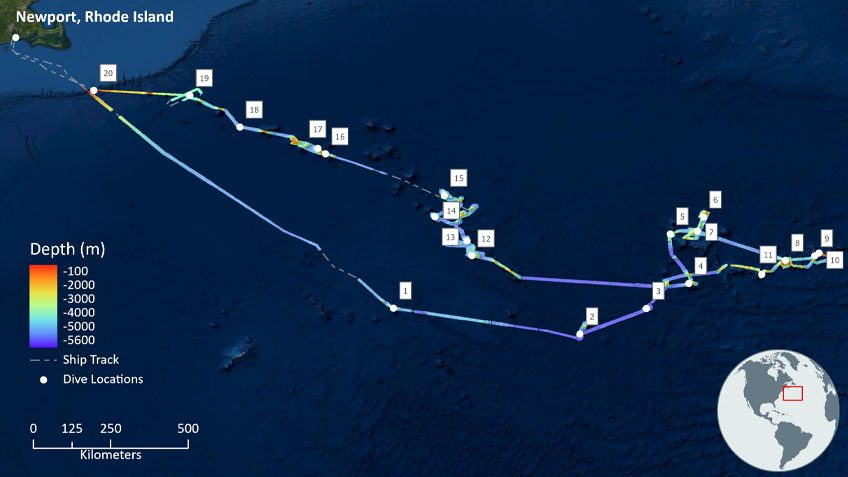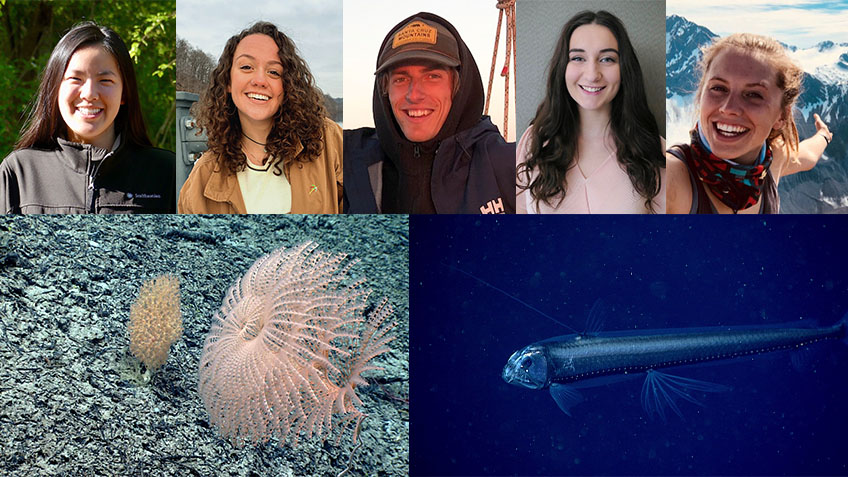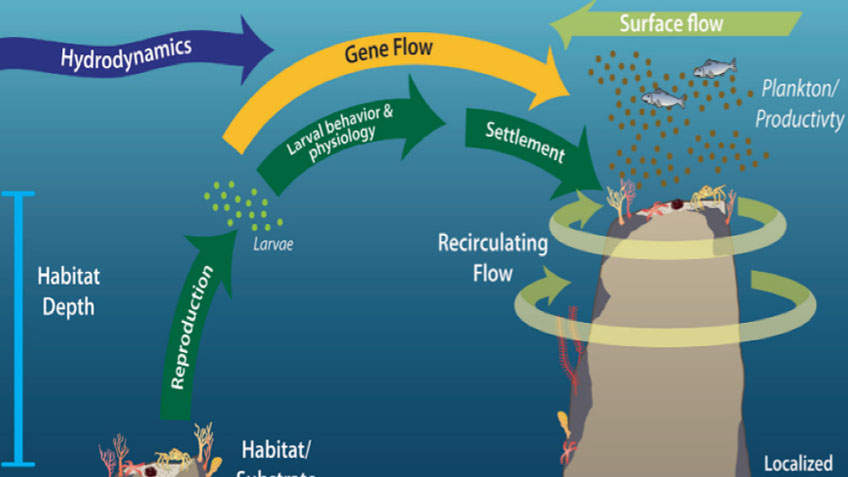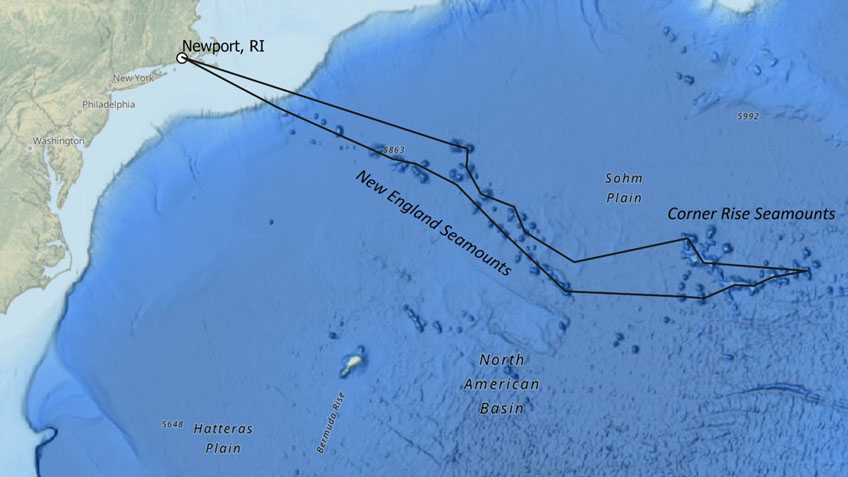The features below will help you to understand the goals and objectives of the expedition and provide additional context and information about the places being explored and the science, tools, and technologies being used.
Expedition Summary
Mapping and remotely operated vehicle (ROV) operations yielded observations of numerous potential new species and new animal behaviors, geological samples to expand our understanding of ferromanganese crusts, data on 20 seamounts that had never been mapped before, and the engagement of audiences around the world.
What’s In a Nodule?
During the recent 2021 North Atlantic Stepping Stones expedition, scientists discovered large fields of charismatic round rocks identified as ferromanganese nodules on two different regions of Gosnold Seamount. But what is a nodule?
Video Feature: A Hungry Sea Star
During Dive 11 of the 2021 North Atlantic Stepping Stones expeditions, scientists observed this sea star, Sthenaster emmae, feeding on a whip coral in the genus Calyptophora at a depth of 1,219 meters (4,000 feet).
Discovering and Annotating
During the 2021 North Atlantic Stepping Stones expedition, I participated as a scientist from shore with NOAA Ocean Exploration as part of my Ernest F. Hollings Scholarship Program internship this summer. This included participating through the science teleconference line and chat room.
Video Feature: Spongebob and Patrick
Video of a yellow sponge (genus Hertwigia) and pink sea star (genus Chondraster) collected during Dive 19 of the 2021 North Atlantic Stepping Stones expedition. Images of the pair have captured the attention of the public and the media due to their resemblance to the cartoon characters SpongeBob SquarePants and Patrick Star.
A Look Below the Seafloor With Sub-Bottom Profiler Data
Using the mapping tools on NOAA Ship Okeanos Explorer, data are collected to produce high-resolution bathymetric maps of the seafloor similar to topographic maps common for areas on land, but under water, to measure layers and currents in the water column, and to look below the seafloor to see what is hidden, even from the cameras of remotely operated vehicle Deep Discoverer.
National Intern Day 2021
At NOAA Ocean Exploration, a core part of our mission is engaging the next generation of ocean explorers through internships. As we celebrate National Intern Day 2021, get to know some of this year’s interns!
Mapping and Diving Go Together Like Peanut Butter and Jelly
You likely know that during remotely operated vehicle (ROV) expeditions there are two main operations occurring, generally ROV dives during the day and mapping the seafloor overnight. But did you know that these operations are strongly linked?
Sailing in the Cloud
As a geologist, I had written off working from home a long time ago, as most of my work depended on data collection in the field. 2020 really threw this dedicated and resilient team a challenge, and the solution to it was cloud-based mapping.
The Monument in Your Backyard
A mere 130 miles southeast of Cape Cod, Massachusetts, lies the Northeast Canyons and Seamounts Marine National Monument. One of just five marine national monuments — and the only one off the U.S. mainland — it protects an area of open ocean roughly the size of Connecticut.
Shore-side Data Management of Deep-sea Specimens
In addition to high-definition video data and environmental parameters such as water temperature, salinity, dissolved oxygen, location, and depth, remotely operated vehicle Deep Discoverer collects highly valuable biological and geological specimen samples. Managing these physical samples from the depths of our ocean is high-priority work.
Video Feature: A Colorful Ctenophore
Belonging to the ctenophore order Lobata, family Lampoctenidae, this animal was initially identified as being the bloody belly ctenophore, though emerging research suggests that this yellow ctenophore might be a new and different red-belly ctenophore species.
Recap: Exploring the Corner Rise Seamounts
As we transition to our next set of dive sites on the New England Seamounts (mapping along the way, of course!), we asked our expedition team leads what was most interesting, most surprising, or aspect from which they learned the most during our eight dives on the Corner Rise Seamounts.
Video Feature: Cerianthid Anemone
Cerianthid or tube anemones, belonging to the subclass Ceriantharia, are rather distant relatives of sea anemones. All tube anemones have a quite uniform appearance, with an elongated body and two crowns of non-branched tentacles.
How Long Must I Wander?
We talk about seamount chains being stepping stones for organisms, about finding the same species along these chains and about the often-dense communities of deep-sea corals and sponges that live there. But how does that happen, when these animals can’t swim?
The Importance of Exploring the Sargasso Sea: ‘Spiritual and Aesthetic Delight’ as Well as Conservation
The Sargasso Sea is a distinctive ecosystem located on the high seas. Its boundaries are defined by currents circulating the North Atlantic sub-tropical gyre, including the Gulf Stream and the Antilles Current. The Sargasso Sea is named for the floating sargassum that populates its surface – a kind of macroalgae that is designed for a pelagic (open ocean) existence, never attaching to the bottom at any point in its life cycle.
Oh, (a Few of) the Places We’ll Go!
While most of our dives during this expedition will occur on seamounts that NOAA Ocean Exploration has not explored yet via NOAA Ship Okeanos Explorer, we will be revisiting a few familiar seamounts within the New England Seamount chain from dives in 2014 and 2019.
Tiptoeing Through the North Atlantic
Some seamounts form long chains as the continental shelf glided over a hotspot in the Earth’s crust, creating seamounts one after another in a long succession stretching back over 100 million years. These seamount chains can form what we call “stepping stones” across the seafloor—areas of habitat that are suitable for a wide variety of species to settle, colonize, and live.
Expedition Plan
From June 30 through July 29, 2021, NOAA Ocean Exploration and partners will conduct the 2021 North Atlantic Stepping Stones: New England and Corner Rise Seamounts expedition, a telepresence-enabled ocean exploration expedition on NOAA Ship Okeanos Explorer to collect critical baseline information about unknown and poorly understood deepwater areas off the eastern U.S. coast and high seas.























